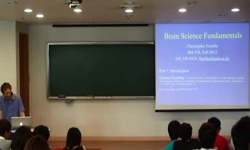To evaluate the magnetic resonance imaging and electron microscopic findings of the hyperacute stage of cerebral fat embolism in cats and the time needed for the development of vasogenic edema. Magnetic resonance imaging was performed at 30 minutes (g...
http://chineseinput.net/에서 pinyin(병음)방식으로 중국어를 변환할 수 있습니다.
변환된 중국어를 복사하여 사용하시면 됩니다.
- 中文 을 입력하시려면 zhongwen을 입력하시고 space를누르시면됩니다.
- 北京 을 입력하시려면 beijing을 입력하시고 space를 누르시면 됩니다.
https://www.riss.kr/link?id=A106793156
- 저자
- 발행기관
- 학술지명
- 권호사항
-
발행연도
2005
-
작성언어
English
- 주제어
-
등재정보
KCI등재
-
자료형태
학술저널
-
수록면
31-36(6쪽)
- 제공처
-
0
상세조회 -
0
다운로드
부가정보
다국어 초록 (Multilingual Abstract)
To evaluate the magnetic resonance imaging and electron microscopic findings of the hyperacute stage of cerebral fat embolism in cats and the time needed for the development of vasogenic edema. Magnetic resonance imaging was performed at 30 minutes (group 1, n=9) and at 30 minutes and 1, 2, 4, and 6 hours after embolization with triolein (group 2, n= 10). As a control for group 2, the same acquisition was obtained after embolization with polyvinyl alcohol particles (group 3, n=5). Electron microscopic examination was done in all cats. In group 1, the lesions were iso- or slightly hyperintense on T2-weighted (T2W) and diffusion-weighted (DWIs) images, hypointense on the apparent diffusion coefficient (ADC) map image, and markedly enhanced on the gadolinium-enhanced T1-weighted images (Gd-T1WIs). In group 2 at 30 minutes, the lesions were similar to those in group 1. Thereafter, the lesions became more hyperintense on T2WIs and DWIs and more hypoinfense on the ADC map image. In group 3, the lesions showed mild hyperintensity on T2WIs at 6 hours but hypointensity on the ADC map image from 30 minutes, with a tendency toward a greater decrease over time. Electron microscopic findings revealed discontinuity of the capillary endothelial wall, perivascular and interstitial edema, and swelling of glial and neuronal cells in groups 1 and 2. The lesions were hyperintense on T2WIs and DWIs, hypointense on the ADC map image, and enhanced on Gd-T1WIs. On electron microscopy, the lesions showed cytotoxic and vasogenic edema with disruption of the blood-brain barrier.
동일학술지(권/호) 다른 논문
-
Trichomonas vaginalis Adhesion Protein 33: A Useful Target for Diagnosis of T. vaginalis
- The Korean Society for Biomedical Laboratory Sciences
- Joo Kyung Bok
- 2005
- KCI등재
-
Effects of Fenofibrate on Adipogenesis in Female C57BL/6J Mice
- The Korean Society for Biomedical Laboratory Sciences
- Jeong Sunhyo
- 2005
- KCI등재
-
- The Korean Society for Biomedical Laboratory Sciences
- Suh Dong Kyun
- 2005
- KCI등재
-
- The Korean Society for Biomedical Laboratory Sciences
- Park Byung-Rae
- 2005
- KCI등재





 ScienceON
ScienceON





